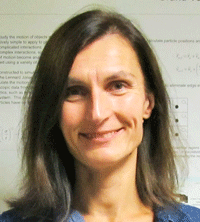Dr. Maja Krcmar

(Maya Krchmar)
Professor of Physics
253 Padnos Hall of Science
Department of Physics
Tel: (616) 331-3004
Fax: (616) 331-3740
Email: [email protected]
Education
- Ph.D. in Physics (Condensed Matter Theory), Texas A & M University (2001)
- M.S. in Physics, Texas A&M University (1998)
- B.S. in Theoretical and Experimental Physics, University of Belgrade, Serbia (1995)
Professional Experience
- Professor of Physics, Grand Valley State University (GVSU), 08/2017- Present.
- Associate Professor of Physics, GVSU, 08/2010 – 08/2017.
- Assistant Professor of Physics, GVSU, 08/ 2006 – 08/2010.
- Visiting Assistant Professor of Physics, GVSU, 08/2004 – 05/2006.
- Adjunct Faculty, GVSU, 01/2004 – 05/2004.
- Post-doctoral Research Associate, Oak Ridge National Laboratory, 03/2002 – 12/2003.
- Teaching and Research assistant, Texas A&M University, 09/1996 – 12/2001.
- Teaching Assistant, University of Belgrade, 05/1995 – 05/1996
Teaching
Dr. Krcmar has taught courses across the undergraduate physics curriculum:
- Introductory inquiry-based courses (Mechanical and thermal world PHY 201 and Electricity, Magnetism and Optics, PHY 204).
- Mathematical Topics in Physics I and II, PHY 210 and 211 (introductory level, calculus-based courses in lectures and discussions format).
- General Physics I and II, PHY 220 and 221 (introductory level, algebra-based courses; lectures, discussions, and laboratories).
- Principles of Physics I and II, PHY 230 and 231 (introductory level, calculus-based courses; lectures, discussions, and laboratories).
- Intermediate and Advanced courses: Modern Physics (PHY 302), Intermediate Mechanics (PHY 330), Advanced Mechanics (PHY 430), Electromagnetic Fields (PHY 340), Numerical Methods in Physics (Computational Physics in Python) (PHY 380) and Solid State Physics (PHY 370).
Research:
Dr. Krcmar’s research interests since 2020 (the COVID 19 pandemic) are in the area of mathematical modelling of infectious diseases. Her research used to be in the areas of computational materials science (based on the ab-initio calculations) and theoretical semiconductor physics, in particular: structural phase transformations in shape-memory and other transition-metal alloys, superhardness in transition-metal diborides, formation, stability and growth of nanoclusters in metallic hosts, absorption of hydrogen molecules in graphite, magnetism-driven phase transformations in iron-cobalt systems at reduced size, diffusion of solutes in metallic matrices, ferroelectricity in perovskite transition metal oxides and phase stability of small ferroelectrics, as well as multi-carrier transport in semiconductors with surface carrier injection due to illumination. Dr. Krcmar has also worked with physics undergraduates on a variety of computational projects, such as molecular dynamics simulation of phase transformation, elastic properties of selected solids, studies of numerical methods in quantum-mechanical problems, etc.
Recent Publications:
- M. Krcmar, German D. Samolyuk, and James R. Morris, Stacking faults and alternate crystal structures for the shape-memory alloy NiTi, Phys. Rev. Materials 4, 103606 (2020).
- M. Krcmar and Wayne M. Saslow, Irreversible thermodynamics and Shockley recombination velocity: Application to photoabsorption near a surface, Phys. Rev. B 97, 085308 (2018).
- M. Krcmar and Wayne M. Saslow, Characteristic lengths for three-carrier transport with spin-flip and electron-hole recombination, Phys. Rev. B 93, 195401 (2016).
- M. Krcmar and J. R. Morris, A comparative first-principles study of martensitic phase transformations in TiPd2 and TiPd intermetallics," J. Phys.: Condensed Matter, 26, 135401 (2014).
- M. Krcmar and C. L. Fu, Effect of lattice anharmonicity in the structural phase transformation of Laves phase HfV2 alloy: A first-principles investigation, Acta Materialia, 61, Issue 19, 7473-7480 (2013).
- H. Zhao, C. L. Fu, M. Krcmar, and M. K. Miller, Effect of strain on the stabilization of oxygen-enriched nanoclusters in Fe-based alloys, Physical Review B 84, 144115 (2011)

